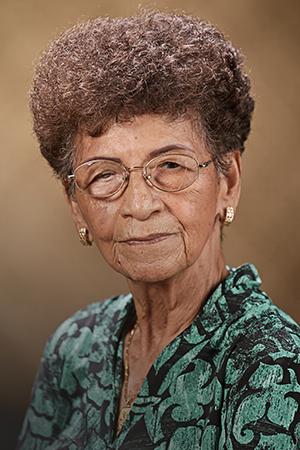The war brought her family closer together

Clad in a white dress and moccasins, Sylvia Iglesias San Nicolas Punzalan (1927 – ) was preparing to honor Santa Marian Kamalen on 8 December 1941 at the island’s annual procession around the capital village of Hagåtña. She was 14 years old, the sun was shining, and her family, along with the rest of the island, had readied themselves for a day of tradition and celebration.
But the day changed in an instant. Suddenly there was panic. Sirens sounded. Loud announcements were coming from government officials over the blow horn. And a Spanish priest was shouting for patrons to go find their families.
World War II had made its way to Guam and the Japanese were invading through the island’s beaches.
My older brother Frank grabbed my hand and we ran back to our house in East Hagåtña.
Slyvia Iglesias San Nicolas Punzalan
She recalls the family home that sat beachside and that would soon be destroyed by the war. That same area is now lined with local businesses with not a sign of the families who had once lived there.
Punzalan, her six siblings, and her parents had little time to evacuate the area. They took what they could – clothes, shoes, food and other necessities for easy carry and transport.
Packed up and rode up to Machananao
By noon that day, the family, packed into a jeepney-style vehicle, had arrived at their ranch up north in Machananao. This is where they would live, hide, and survive the first two years of the occupation.
Only Punzalan’s immediate family and her maternal grandparents lived at the ranch throughout the war. They were near aunts, uncles and cousins who all lived in temporary shacks. This arrangement molded a tight-knit environment, where Punzalan and her family would rely on one another day-in and day-out.
The war changed our family. It brought us closer.
Sharing, giving and helping
She explained that the seclusion from others made the family stronger, whether through sharing, giving, or helping. This came out during the daily routines at the ranch. The kids helped with planting and harvesting eggplants and beans, raising the chickens, and cleaning the pig pen. For drink, they would consume coconut juice or rain water.
Our family was very fortunate, because my grandparents lived on the ranch before the war.
They had plants and livestock, which was not the case for many other families at the time. At night, they would sleep in close quarters. Punzalan recalls sharing a woven mat (guåfak) with her younger sister Maria, handmade by their Nana. Their father, Francisco, guarded the ranch while the rest slept. During the day, they had a dog tied to a coconut tree that alerted the family if someone was nearby. While they had a routine, they were never completely settled, knowing that the Japanese could come at anytime and with any demand or order.
After a year had passed, the children were forced back to school. Punzalan and her siblings walked about 45 minutes to their school in Machananao, the area that is now home to D.L. Perez Elementary School. Lessons were taught in Japanese, and conversing in English and CHamoru was forbidden.
We had to speak Japanese or we would get slapped.
But sometimes Punzalan and her two closest schoolmates, Leonila and Ana Leon Guerrero, would try to speak quietly to one another.
She said everyone was waiting for the Americans to come because they knew they would come. This certainty, fortified by strong faith, continued to carry the family through the days of war.
Catholic services were offered about a mile from the ranch at the Machananao church. Her parents stayed home, but would allow Punzalan and her siblings to attend church under the watch of their eldest brother, Frank.
Every night we would say the rosary as a family. This is something I still do today … every day I pray.
Some were called by the taotaomo’na
There were also the beliefs in the ancestral spirits of the taotaomo’na.
The taotaomo’na looked like humans, but not everyone could see them. My sister Priscilla would always see taotaomo’na during the war. A lady or a little boy would call her into the jungle, but she was never scared.
The fears of war were always countered with strength. That strength was particularly important the day an interpreter came to the ranch with an order for the family to report to the southern area of Manenggon.
The family walked the dirt roads alongside other families, and after a long day and long night, they arrived at the Japanese concentration camp. The tension among the Japanese was rising. Armed with machine guns, they were prepared to kill and fight the enemy.
Punzalan, her family, along with most of the rest of the island residents, remained at the Manenggon concentration camp with hope and perseverance until freed by the Americans.
That day came 21 July 1944. The Americans began their invasion to liberate the people of Guam from the terrors of the Japanese occupation.
Later she married Jose Anderson Punzalan. Together they raised nine children.
My hope is that my family will learn the CHamoru language and keep the culture alive. And I’d like for my children to remember all the things that I’ve taught them, so that that they can pass it down to the younger generations.
Editor’s note: Reprinted and adapted, with permission, from Guam War Survivors Memorial Foundation by Audreya JP Taitano.
